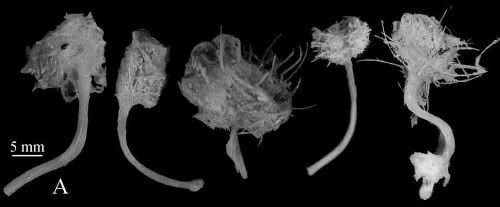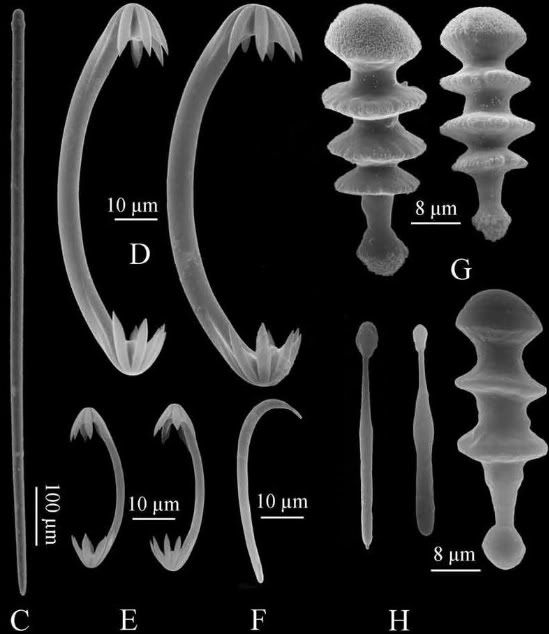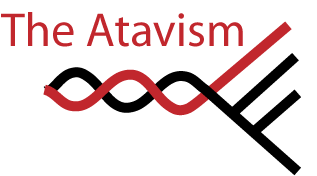Sunday, May 23, 2010
Sunday Spinelessness - Attack of the Killer Sponge!
![]() Chondrocladia turbiformis, a ruthless carnivore hauled from bottom of the sea off new New Zealand by NIWA scientists, has been named among the top ten new species described last year. This abyssal predator isn't a kraken, a plesiosaur that time forgot or even an improbable (but awesome) hybrid. It's a sponge.
Chondrocladia turbiformis, a ruthless carnivore hauled from bottom of the sea off new New Zealand by NIWA scientists, has been named among the top ten new species described last year. This abyssal predator isn't a kraken, a plesiosaur that time forgot or even an improbable (but awesome) hybrid. It's a sponge.
It may come as some surprise that a sponge can be a carnivore, or even that sponges are animals. Sedentary as they are, sponges tick all the boxes for inclusion in the kingdom Anamalia. They eat other organisms to make energy and build their body (differentiating them form plants and algae), they have cells enclosed by membranes (not cell walls like plants and fungi) and they are truly multi-cellular, with specialised cell-types (which sets them apart from protists). On the other hand, sponges are pretty unusual animals. Sponges have no nervous system, no gut, not circulatory system and their cells don't form tissues. The relative simplicity of sponges helps us to understand the evolutionary history of animals, by plotting some of the characteristics of modern animals onto a phylogeny we can see what order those characters evolved in:

So, sponges are useful in trying to understand the evolution of animals. But we shouldn't view modern species as steps along a path toward more complex animals. Sponges are amazing creatures in their own right, for a start they're the only animals that don't have a mouth. Most sponges feed by drawing water into the their body through pores and absorbing bacteria and small algae from that water with specialized cells on the inner surface of their bodies. The cells of the inner surface have two sets of projections to help them with this task. The tail-like flagella which beat together to get water flowing over the absorbing cells and the hair-like micro-villi which increase the cells surface area and make them more efficient absorbers (the guts of more complex animals play the same trick on a larger scale). Most sponges further increase the efficiency of this process by taking the form, and the function, of a chimney. The tubular forms are help together by a mesh of small calcium carbonate structures called spicules.
Filter feeding works well in relatively nutrient-rich shallow waters, but scientists have pulled odd looking sponges up from the bottom of the ocean. Some of those sponges still had the characteristic sponge filter feeding system, but others had lost it all together. Quite how these strange sponges were getting by in the dark and unproductive abyss without even the normal sponge feeding system remained a mystery until 1995 when French researchers found a relative of the deep sea sponges in a relatively shallow submarine cave. Abestopluma hypoa gave scientists their first chance to observe these sponges, and what they saw was amazing: it was a carnivore. In life A. hypoa projects a set of filaments into the water. Those filaments are covered in tiny spicules which act like Velcro (that's the author's own simile) grabbing passing crustaceans and holding them in place. It takes a while for the sponge to get its meal, cells make contact with prey within an hour but the actual ingestion follows a period of cell growth and movement which completely covers the animal after a day. It takes another couple of days to completely digest the crustacean.
Since that first discovery scientists have discovered many more carnivorous sponges, with a surprisingly large number coming from sea mounts off New Zealand and in the Southern Ocean. The topic of today's post (I knew I'd get to it eventually...), Chondrocladia turbiformis, is one of the newest killer sponges, and it looks a bit like a mushroom:

The Chondrocladia are a bit of a special case among the carinovore-sponges because they have retained the rudiments of their filter feeding system. They don't appear to use it to supplement their diet, rather it's been re-purposed to inflate a balloon like structure the sponge uses to help capture prey. (For a stunning example of this structure in a live sponge see the photo that illustrates Olivia Judson's article here.). But the thing that really distinguishes C. turbiformis from the already amazing carnivorous sponges are its spicules:

Beautiful as they are, those symmetrical curved claws in D and E are run of the mill for Chondrocladia. The spinning top spicules in G and H are something quite different. It was only through the description of C. turbiformis and a related species C. tasminae that it became apparent these spicules, with have been named trochirhabds, are present in some modern Chondrocladia species. It's not extactly clear what these cool little spiclues are doing in modern Chondrocladia but they give us a clue to the history of carnivorous sponges. Spicules just like the trochirhabds described from C. turbiformis have been found in marine sediments from the Jurassic period. It appears the carnivorous sponges that it took us until 1995 to learn about have been living in the oceans for at least 150 million years.
Vacelet, J., Boury-Esnault, N., Fiala-Medioni, A., & Fisher, C. (1995). A methanotrophic carnivorous sponge Nature, 377 (6547), 296-296 DOI: 10.1038/377296a0 Jean Vacelet,, Michelle Kelly, & Monika Schlacher-Hoenlinger (2009). Two new species of Chondrocladia (Demospongiae: Cladorhizidae) with a new spicule type from the deep south Pacific, and a discussion of the genus Meliiderma Zootaxa (2073), 57-68
Labels: carnivorous sponge, citizen science, might interest someone, porifera, sci-blogs, sponge, sunday spinelessness, taxonomy



